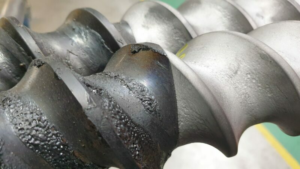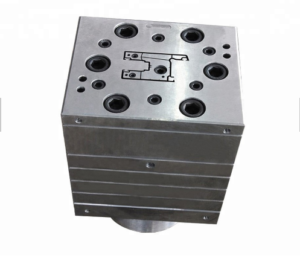The typical deposit you can get on an extrusion screw is a well-known problem. The deposit of cured extrusion medium on the extrusion mold requires you to perform a deep cleaning to maintain the quality and the original form factor of your products. Because of the heat, the pressure and the tight fits, this is a very persistent form of pollution within the industry and it requires a deep cleaning!

Typical sorts of contamination on extrusion parts are EPDM, rubber, PE and other plastics. Sandblasting isn’t the right technique to clean such parts because the fit of the screw is very important. The sand removes good material and will shorten the life of the extrusion screw due to damage to the fit and the sharp corners of the screw. Pyrolysis is also sometimes used, but this takes a long time and most of the time, this can’t be done on site (just like chemical cleaning).
Similar parts such as hot runners, core pullers and extrusion cylinders can also be perfectly cleaned with laser cleaning. We’re even able to get to the inside of narrow cylinders by using mirrors so that we can get everything out.

The thin shapes in the extrusion molds are sensitive to the deposit of cured extrusion material. Most cleaning techniques have the risk of removing important material or that thermal deformation can arise in the extrusion mold. Manual cleaning is still a regularly used technique to clean these molds, but it’s very time consuming and doesn’t always give you the best result. Laser cleaning is very suitable for the cleaning of extrusion molds because the laser light is able to reach the smallest corners and edges and removes all the contamination there, up to a molecular level. The reflection on the material itself also helps with this, making it even possible to get “around the corner” when cleaning very complex parts.
Laser cleaning extrusion parts has the advantage that it’s fast and cleans deeper than any other technique, without the risk of wear on the parts. Once the laser beam is through the contamination, it will no longer have any effect. This way, it’s not possible to remove too much material. The light beam heats up the contamination in a very short period of time, which will cause the contamination to evaporate. The parts themselves will barely heat up because it happens so fast, this also means that you’ll be able to use your parts again shortly after the cleaning. That same light beam is, however, not powerful enough to have an effect on the extrusion parts themselves and thus will get reflected on it without any effect.
The cleaning can be done manually by an operator, but for larger quantities, an automatic cleaning line can be built, this cleaning line is able to clean the parts fully automatically and also very consistently.
Laserflux has a workplace with an automated cleaning line where we can clean your extrusion parts on. We come to you to pick up the parts and we’ll bring them back to you a few days later, perfectly clean.
If you rather want us to come to you with a mobile machine and clean the parts directly on site, that’s also possible. It will only take us a few hours so you won’t have to take a long break and you’ll be able to continue producing after a few hours. We also don’t need a shielded room, which we need with sandblasting. If necessary, we will even clean the parts right next to the extrusion press, so no minute will be wasted. Name one technique giving you these same benefits?
Contact us if you would like a free demo or just an explanation about laser cleaning.
Interested in laser cleaning? Experience a free demo at our demo center to see all the advantages of laser cleaning for yourself.